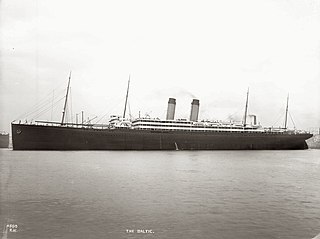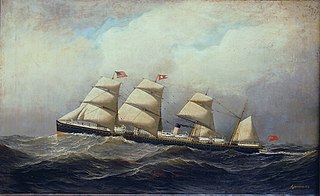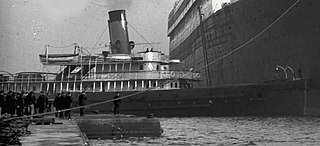
An ocean liner is a passenger ship primarily used as a form of transportation across seas or oceans. Liners may also carry cargo or mail, and may sometimes be used for other purposes.

The White Star Line (WSL), was a British shipping company. Founded out of the remains of a defunct packet company, it gradually rose up to become one of the most prominent shipping lines in the world, providing passenger and cargo services between the British Empire and the United States. While many other shipping lines focused primarily on speed, White Star branded their services by focusing more on providing comfortable passages for both upper class travellers and immigrants.

SS Oceanic was the White Star Line's first liner and an important turning point in passenger liner design. Entering service in 1871 for Atlantic crossings, she was later chartered to Occidental and Oriental Steamship Company (O&O) in 1875. The ship provided passenger service for O&O in the Pacific until 1895 when she was sold for scrap.

RMS Republic was a steam-powered ocean liner built in 1903 by Harland and Wolff in Belfast, and lost at sea in a collision in 1909 while sailing for the White Star Line. The ship was equipped with a new Marconi wireless telegraphy transmitter, and issued a CQD distress call, resulting in the saving of around 1,500 lives. Known as the "Millionaires' Ship" because of the number of wealthy Americans who traveled by her, she was described as a "palatial liner" and was the flagship of White Star Line's Boston service. This was the first important marine rescue made possible by radio, and brought worldwide attention to this new technology.

SS Atlantic was a transatlantic ocean liner of the White Star Line that operated between Liverpool, United Kingdom, and New York City, United States. During the ship's 19th voyage, on 1 April 1873, she struck rocks and sank off the coast of Nova Scotia, Canada, killing at least 535 people. It remained the deadliest civilian maritime disaster in the North Atlantic Ocean until the sinking of SS La Bourgogne on 2 July 1898 and the greatest disaster for the White Star Line prior to the loss of Titanic in April 1912.

RMS Baltic was an ocean liner of the White Star Line that sailed between 1904 and 1933. At 23,876 Gross register tonnage, she was the world's largest ship until 1905. She was the third of a quartet of ships, all measuring over 20,000 gross register tons, dubbed The Big Four.
Four ships of the White Star Line have been named SS Belgic:

RMS Celtic was an ocean liner owned by the White Star Line. The first ship larger than SS Great Eastern by gross register tonnage, Celtic was the first of a quartet of ships over 20,000 tons, the dubbed The Big Four. She was the last ship ordered by Thomas Henry Ismay before his death in 1899. The second liner of her name she was put into service in 1901. Her large size and her low but economical speed inaugurated a new company policy aiming to favour size, luxury and comfort, to the detriment of speed.

RMS Adriatic was a British ocean liner of the White Star Line. She was the fourth of a quartet of ships of more than 20,000 GRT, dubbed The Big Four. The ship was the only one of the four which was never the world's largest ship. However, she was the largest, the fastest, and the most luxurious of the Big Four, being the first ocean liner to have an indoor swimming pool and a Turkish bath.

SS Adriatic was the first of two White Star Line ocean liners to carry the name Adriatic. The White Star Line's first four steamships, the met with great success in the trans-Atlantic market, and the line decided to build two more. The first of these was the SS Adriatic, which was built by Harland and Wolff and launched on 17 October 1871; the second was the Celtic.

SS Baltic was an ocean liner owned and operated by the White Star Line. Baltic was one of the first four ships ordered by White Star from shipbuilders Harland and Wolff after Thomas Ismay bought the company, and the third of the ships to be delivered.

SS Republic was an ocean liner built in 1871 by Harland and Wolff for White Star Line. It was intended to be the last of four vessels forming the Oceanic class, before two new ships were commissioned. After a rough maiden voyage from Liverpool to New York City on 1 February 1872, the ship was chosen to be on White Star Line's first voyage on the South Atlantic and Pacific line with four other ships, destined for Chile. In 1874, the construction of modern ships SS Germanic and SS Britannic led to SS Republic's becoming the standby vessel of White Star Line. It occupied this position for 15 years, and attempts were made to modernise it in 1888. When RMS Teutonic and RMS Majestic entered service in the following year, the Republic became surplus to White Star's needs.

MS Baltic Star is a cruise ship owned by Rederi Hotell Fartyget BJ AB that was operated on services between Stockholm, Sweden and Helsinki, Turku and most recently Mariehamn on Åland (Finland). She was built in 1953 as a passenger liner at Finnboda shipyard in Nacka, Sweden as SS Birger Jarl for Rederi AB Svea. In 1973 she was sold to Jakob Lines, was renamed SS Bore Nord and converted into a ferry. In 1978 she was bought back by the Ånedin Line and was renamed SS Baltic Star. In 1982 the ship's original steam engines were replaced by diesel engines; the ship's prefix hence altered to MS. In 1989 the engines were again replaced by new diesels. In 2002 the ship reverted to the name Birger Jarl, and in 2020 back to the Baltic Star name.
A number of ships of the Holland America Line have been named Statendam, the name of an old dike on the island of Goeree-Overflakkee:
SS Columbus may refer to one of the following passenger steamers:
SS Vaderland may refer to one of the following ships of the Red Star Line named after the Dutch word for fatherland:

The "Big Four" were a quartet of early-20th-century 20,000-ton ocean liners built by the Harland & Wolff shipyard for the White Star Line, to be the largest and most luxurious ships afloat. The group consisted of Celtic, Cedric, Baltic and Adriatic.
At least two ships have been named SS Zealandic:
Two ships of the White Star Line have borne the name SS Gallic, an adjectival reference to France:

SS Magnetic was a passenger tender of the White Star Line built in 1891. She was laid down at the Harland and Wolff Shipyards in Belfast, Ireland. Magnetic was sold to a different company in 1932 and renamed Ryde, and scrapped in 1935.












